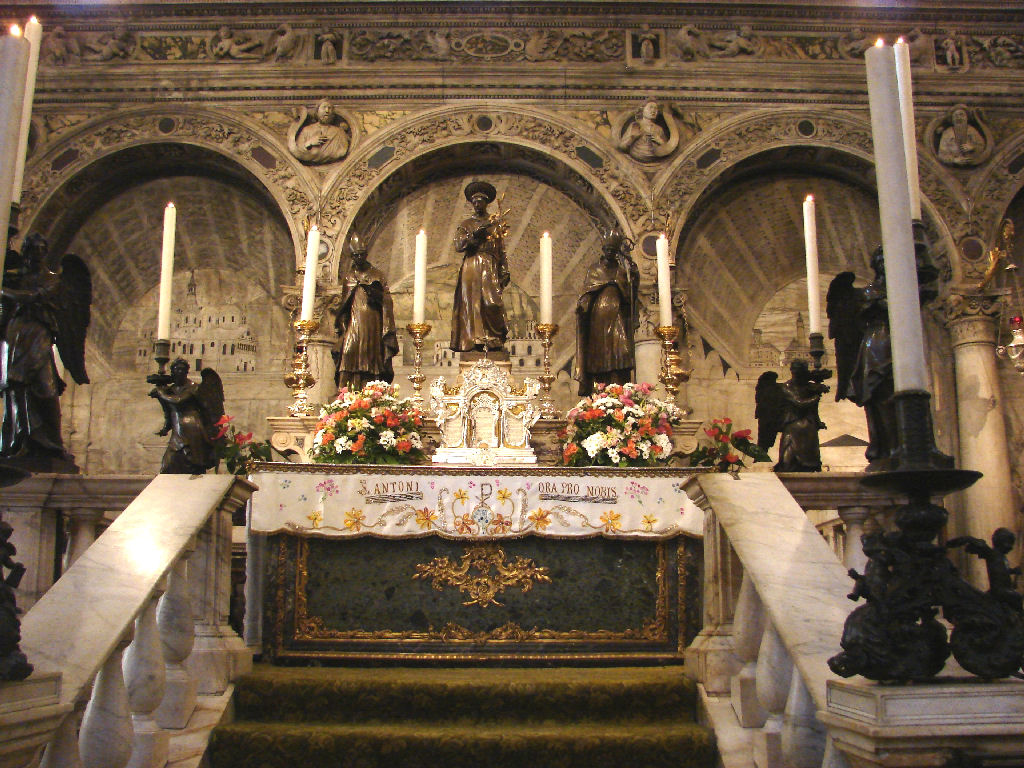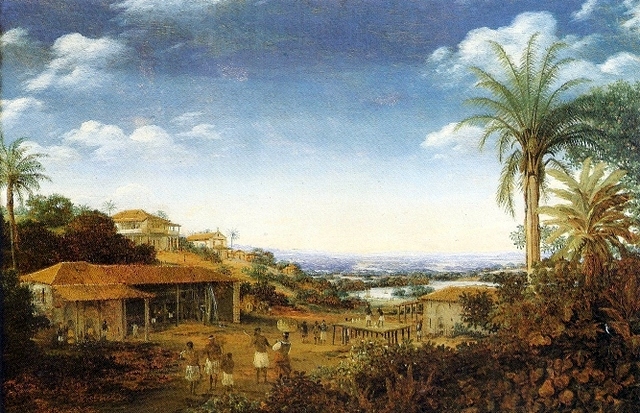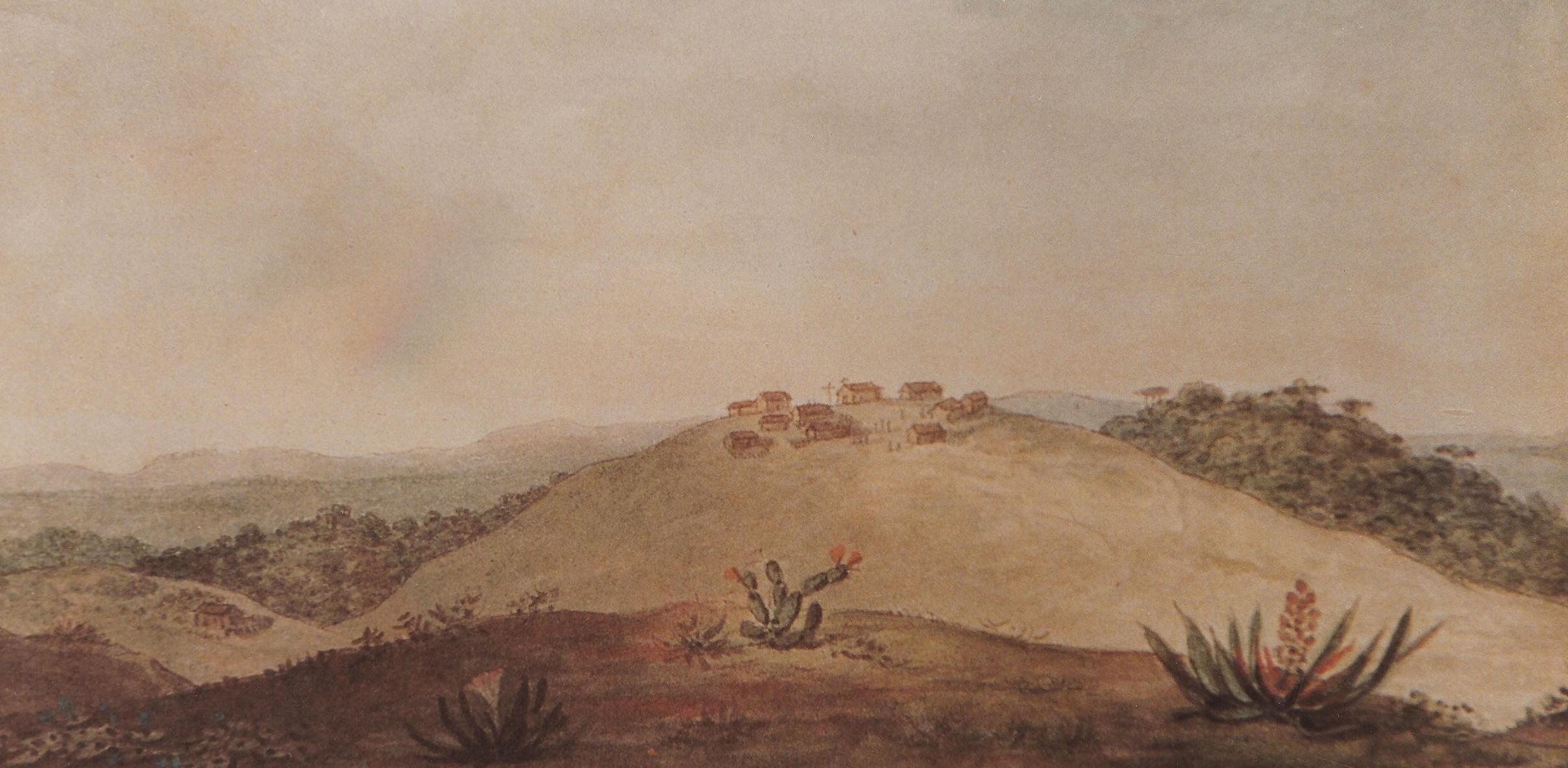|
Cafundó (film)
''Cafundó'' is 2005 Brazilian historical drama film written and directed by Paulo Betti and Clóvis Bueno and starring Lázaro Ramos. The film is a biopic based on miracle worker ''preto velho'' João de Camargo of Sorocaba and is based on the book ''João de Camargo de Sorocaba: O Nascimento de uma Religião'' by Carlos de Campos and Adolfo Frioli. The title comes from a former ''quilombo'', the source of João de Camargo's original spiritual inspiration, located in today's Salto de Pirapora. Plot São Paulo state, 1890s. João is a former slave and the son of an Orisha priestess and works as a muleherd for a ''coronel''. One day, he and his close friend Cirino decide to leave the farm. João takes his mother to Cafundó, the bastion of Afro-American religion in the vicinity. However, João leaves the community and takes errands to work in menial jobs. He meets a possessed white prostitute named Rosário and falls in love. Only after an unhappy marriage with Rosário and his moth ... [...More Info...] [...Related Items...] OR: [Wikipedia] [Google] [Baidu] |
Paulo Betti
Paulo Sérgio Betti (born 8 September 1952) is a Brazilian actor, playwright, and stage director. He also works occasionally as film producer and director. Biography Paulo Sérgio Betti was born on 8 September 1952 in Rafard, a small town in the state of São Paulo. In over thirty years of career, Betti has acted in over 20 ''telenovelas'' and in 21 feature films. His most notable role was as the revolutionary Captain Carlos Lamarca in ''Lamarca'' (1994) and '' Zuzu Angel'' (2006), both directed by Sérgio Rezende. For his role in ''Lamarca'', he won the São Paulo Association of Art Critics Award for Best Film Actor in 1995. He also hosted the show ''Novos Nomes em Cena'' of Canal Brasil, where he interviewed young Brazilian actors. Betti was married to actress Eliane Giardini between 1973 and 1997. The couple had two daughters: Juliana (born in 1977) and Mariana (born in 1980). He was also married to actress Maria Ribeiro, mother of his only son João (born on 30 March 2003 ... [...More Info...] [...Related Items...] OR: [Wikipedia] [Google] [Baidu] |
Veneration
Veneration (; ), or veneration of saints, is the act of honoring a saint, a person who has been identified as having a high degree of sanctity or holiness. Angels are shown similar veneration in many religions. Veneration of saints is practiced, formally or informally, by adherents of some branches of all major religions, including Christianity, Judaism,"Veneration of saints is a universal phenomenon. All monotheistic and polytheistic creeds contain something of its religious dimension... " Hinduism, Islam, Buddhism and Jainism. Within Christianity, veneration is practiced by groups such as the Catholic Church, Eastern Orthodox Church, and the Oriental Orthodox Church, all of which have varying types of canonization or glorification processes. In Catholicism and Orthodoxy, veneration is shown outwardly by respectfully kissing, bowing or making the sign of the cross before a saint's icon, relics, or statue, or by going on pilgrimage to sites associated with saints. The Lutheranis ... [...More Info...] [...Related Items...] OR: [Wikipedia] [Google] [Baidu] |
2000s Historical Drama Films
S, or s, is the nineteenth letter of the Latin alphabet, used in the English alphabet, the alphabets of other western European languages and other latin alphabets worldwide. Its name in English is ''ess'' (pronounced ), plural ''esses''. History Northwest Semitic šîn represented a voiceless postalveolar fricative (as in 'ip'). It originated most likely as a pictogram of a tooth () and represented the phoneme via the acrophonic principle. Ancient Greek did not have a "sh" phoneme, so the derived Greek letter Sigma () came to represent the voiceless alveolar sibilant . While the letter shape Σ continues Phoenician ''šîn'', its name ''sigma'' is taken from the letter ''Samekh'', while the shape and position of ''samekh'' but name of ''šîn'' is continued in the '' xi''. Within Greek, the name of ''sigma'' was influenced by its association with the Greek word (earlier ), "to hiss". The original name of the letter "Sigma" may have been ''san'', but due to the earl ... [...More Info...] [...Related Items...] OR: [Wikipedia] [Google] [Baidu] |
Brazilian Biographical Drama Films
Brazilian commonly refers to: * Brazil, a country * Brazilians, its people * Brazilian Portuguese, its dialect Brazilian may also refer to: * "The Brazilian", a 1986 instrumental music piece by Genesis * Brazilian Café, Baghdad, Iraq (1937) * Brazilian cuisine ** Churrasco, or Brazilian barbecue * Brazilian-cut bikini A bikini is a two-piece swimsuit primarily worn by women that features one piece on top that covers the breasts, and a second piece on the bottom: the front covering the pelvis but usually exposing the navel, and the back generally covering ..., a swimsuit revealing the buttocks * Brazilian waxing, a style of pubic hair removal * Mamelodi Sundowns F.C., a South African football club nicknamed ''The Brazilians'' See also * Brazil (other) * ''Brasileiro'', a 1992 album by Sergio Mendes * Brazilian jiu-jitsu, a martial art and combat sport system * Culture of Brazil * Football in Brazil {{Disambiguation Language and nationality disambiguation pa ... [...More Info...] [...Related Items...] OR: [Wikipedia] [Google] [Baidu] |
2005 Biographical Drama Films
5 (five) is a number, numeral and digit. It is the natural number, and cardinal number, following 4 and preceding 6, and is a prime number. Humans, and many other animals, have 5 digits on their limbs. Mathematics 5 is a Fermat prime, a Mersenne prime exponent, as well as a Fibonacci number. 5 is the first congruent number, as well as the length of the hypotenuse of the smallest integer-sided right triangle, making part of the smallest Pythagorean triple ( 3, 4, 5). 5 is the first safe prime and the first good prime. 11 forms the first pair of sexy primes with 5. 5 is the second Fermat prime, of a total of five known Fermat primes. 5 is also the first of three known Wilson primes (5, 13, 563). Geometry A shape with five sides is called a pentagon. The pentagon is the first regular polygon that does not tile the plane with copies of itself. It is the largest face any of the five regular three-dimensional regular Platonic solid can have. A conic is determ ... [...More Info...] [...Related Items...] OR: [Wikipedia] [Google] [Baidu] |
Umbanda
Umbanda () is a religion that emerged in Brazil during the 1920s. Deriving largely from Kardecist spiritism, Spiritism, it also combines elements from African diasporic religions, Afro-Brazilian traditions like Candomblé as well as Roman Catholicism. There is no central authority in control of Umbanda, which is organized around autonomous places of worship termed ''centros'' or ''terreiros'', the followers of which are called ''Umbandistas''. Adherents of this monotheism, monotheistic religion believe in a single God who is distant from humanity. Beneath this entity are powerful non-human spirits called ''Orisha, orixás''. In the more Spiritist-oriented wing of the religion, White Umbanda, these are viewed as divine energies or forces of nature; in more Africanised forms they are seen as West African deities and are offered animal sacrifices. The emissaries of the ''orixás'' are the ''pretos velhos'' and ''caboclos'', spirits of enslaved Africans and of Indigenous peoples in ... [...More Info...] [...Related Items...] OR: [Wikipedia] [Google] [Baidu] |
Slavery In Brazil
Slavery in Brazil began long before the Colonial Brazil, first Portuguese settlement. Later, colonists were heavily dependent on indigenous labor during the initial phases of settlement to maintain the subsistence economy, and natives were often captured by expeditions of bandeirantes (derived from the word for "flags", from the flag of Portugal they carried in a symbolic claiming of new lands for the country). The importation of African slaves began midway through the 16th century, but the enslavement of indigenous peoples continued well into the 17th and 18th centuries. Europeans and Chinese were also enslaved. During the Atlantic slave trade era, Brazil imported more enslaved Africans than any other country in the world. Brazil's foundation was built on the exploitation and enslavement of indigenous peoples and Africans. Out of the 12 million Africans who were forcibly brought to the New World, approximately 5.5 million were brought to Brazil between 1540 and the 1860s. Th ... [...More Info...] [...Related Items...] OR: [Wikipedia] [Google] [Baidu] |
Gramado Film Festival
The Gramado Film Festival () is an international film festival held annually in the Brazilian city of Gramado, Rio Grande do Sul, since 1973. In 1992, the festival began to award Latin American films produced outside of Brazil. It is the biggest film festival in the country. History Formed by the National Cinema Institute (''Instituto Nacional de Cinema - INC'') in January 1973, the Gramado Film Festival was originally launched at the ''Hydrangeas'' Festivity (''Festa das Hortênsias''), where film exhibitions were promoted between 1969 and 1971. The efforts of the artistic community, the press, tourists, and locals made the initiative a successful event. By the 1980s, it was already the most important film festival of Brazil. Awards Currently, the festival grants awards in 24 categories (13 for Brazilian films, eight for international films, and three special awards). Its awards, called "''Kikitos''", are 13 inch statuettes created by the artisan Elisabeth Rosenfeld. Brazilian ... [...More Info...] [...Related Items...] OR: [Wikipedia] [Google] [Baidu] |
Antonina, Paraná
Antonina is a municipality in the state of Paraná (state), Paraná in southern Brazil. As of 2020, the estimated population was 18,949. Geography Antonina has an area of . It is located at . It is 80 km away from Curitiba. The municipality contains 29% of the Roberto Ribas Lange State Park, created in 1994. It contains part of the Pico Paraná State Park, created in 2002. It also holds 30% of the Bom Jesus Biological Reserve, a strictly protected conservation unit established in 2012. History The small town Antonina was former known as “Capela” – as a chapel has been built there in the 18th century. Due to this fact the inhabitants are called “capelistas” until today. The official name is in honor to António, Prior of Crato, King Antonio of Portugal. Culture Antonina hosts a July winter festival promoted by the Federal University of Paraná, which develops several workshops and shows during this time in the village. The carnival takes place within several bl ... [...More Info...] [...Related Items...] OR: [Wikipedia] [Google] [Baidu] |
Paranaguá
Paranaguá (Tupi language, Tupi, 'Great Round Sea') is a city in the state of Paraná (state), Paraná in Brazil. Founded in 1648, it is Paraná's oldest city. It is known for the Port of Paranaguá, which serves as both the sea link for Curitiba, to the west and the capital of Paraná, and as one of the largest ports of Brazil. As of 2020, the city has an estimated population of 156,174 and a population density of 169.92 persons per km², making it the tenth most populated city in the state of Paraná. The total area of the city is . History Early settlement Paranaguá was home to a ''sambaqui'', or midden culture, for several millennia prior to the arrival of the Portuguese. Little is known of the population, which existed along the coast of Paraná. The area was later home to the Carijó people, an extinct subgroup of the Guaraní people. Portuguese explorers captured the Carijó for slave labor. Over time, the remaining Carijó intermarried with whites and African residents ... [...More Info...] [...Related Items...] OR: [Wikipedia] [Google] [Baidu] |
Lapa, Paraná
Lapa is a municipality in the state of Paraná, in the Southern Region of Brazil. The municipality contains the Monge State Park, created in 1960. History Lapa was discovered in 1731, and became municipality on 7 March 1872. Culture Lapa is known for being a historical city in Paraná, Brazil. The cuisine is coxinha with farofa, it is a typical food in Lapa. Geography Climate Lapa is classified as oceanic climate (Köppen climate classification: ''Cfb''). The annual temperature on summer is 27°C, on winter, the temperature reaches to 9°C. Frost are common on winter. See also *List of municipalities in Paraná This is a list of the municipalities in the state of Paraná (PR), located in the South Region of Brazil. Paraná is divided into 399 municipalities A municipality is usually a single administrative division having municipal corporation, corp ...Genealogy of the emigrants from Bukovina in Lapa, Brazil References Municipalities in Paraná {{Para ... [...More Info...] [...Related Items...] OR: [Wikipedia] [Google] [Baidu] |
Ponta Grossa
Ponta Grossa () is a municipality in the state of Paraná, southern Brazil. The estimated population is 355,336 according to official data from the Brazilian Institute of Geography and Statistics and it is the 4th most populous city in Paraná (76th in Brazil). It is also the largest city close to Greater Curitiba region, so within a radius of 186 miles (300 km) of Ponta Grossa. It is also known as ''Princesa dos Campos'' (in English: ''Princess of the Fields'') and ''Capital Cívica do Paraná'' (in English: ''Civic Capital of Paraná''). The city is connected to the ''Caminho das Tropas'' (in English: ''Path of the Troops''), being one of the network of routes used by drovers (''tropeiros'') in the middle of a high hill inside a grassy vegetation. The city is considered of average size, located around a central hill, while most of its growth occurred in the second half of the twentieth century with the weakening of the primary economy. Ponta Grossa is one of the larg ... [...More Info...] [...Related Items...] OR: [Wikipedia] [Google] [Baidu] |



